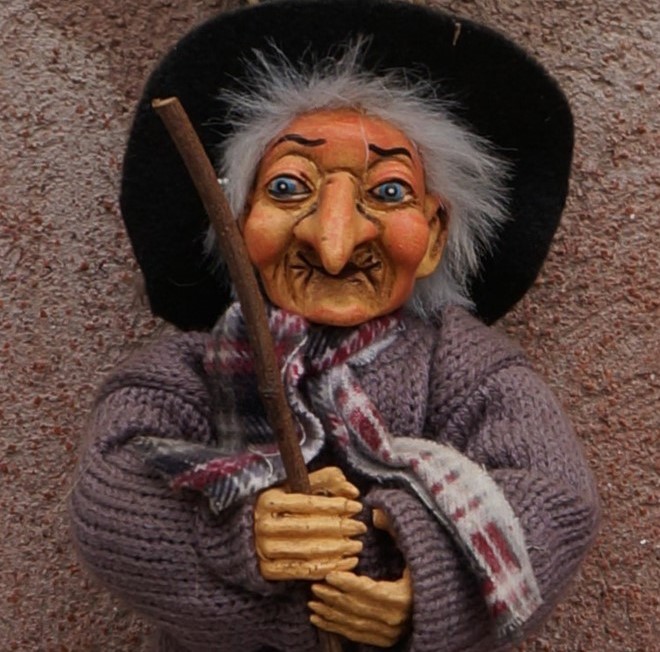More modern interpretations of festive female characters might bring to mind the figure of Mrs Claus, Santa’s legendary wife, but these women take matters into their own hands each year.
La Befana – the kindly Italian crone

Who is Befana?
La Befana – whose name translates in English to ‘the witch’ – is an Italian character in folklore who appears annually on the eve of the Epiphany, 5 January.
What does Befana look like?
Descriptions of Befana are typically very witchy: she is a wizened old woman who wears raggedy clothes and a pointed hat. Her skirt shows its age with the many patches stitched on to cover holes and she drapes a shawl across her shoulders. She has warts on her nose, terrible teeth and even takes to the skies flying on a broomstick.
What does she do?
The character of La Befana is very similar to modern depictions of Father Christmas. On the twelfth day of Christmas, in early January, the magical Befana flies through the sky on her trusty broomstick. Although she has a fearsome appearance, she is a kind witch. She climbs down chimneys and delivers presents to children – those who have been well behaved receive stockings full of sweets and gifts, and for naughty children, a dark caramel sweetie that resembles a lump of coal, as well as onions and garlic.
Where does the story of La Befana come from?
It’s hard to pinpoint exactly where and when stories of La Befana began. One possible origin story for this gift-giving witch lies in the pre-Christian Roman festival of Saturnalia. The Saturnalia was a two-week celebration which began in time for the winter solstice and ran until early January. During the festival, pagans would ascend to the Temple of Juno on Rome’s Capitoline Hill, to have their futures read by an old woman. Perhaps they brought the soothsayer gifts to ensure a happy future predicted.
However, Befana’s name could also be a derivative of ‘Bastrina’, a word for presents specifically given to Strenua, the Roman goddess of wellbeing and the new year. Strenua’s shrine sat atop the Via Sacra, the main street in ancient Rome.
Gryla – the Icelandic Christmas witch

Thorsteinn1996, CC BY-SA 4.0
Who is Gryla?
Gryla’s name loosely translates in English to mean ‘growler’. She is a formidable witch who lives in the Icelandic mountainous hinterlands and punishes badly behaved children.
What does she look like?
Depictions of Gryla often vary, but on the whole she is painted to be a monstrous female. Sometimes she is an ‘ogress’, sometimes she appears with hooves and a horned tail. In some stories, Gryla looks like a sheep who walks upright like a person, in others, she has 300 heads, or a beard and eyes in the back of her head.
Where does Gryla live?
Gryla lives in a cave in the far north of Iceland with her husband. The couple are accompanied by a Yule cat and 13 sons, the Yule Lads. It is thought that Gryla had two husbands – the first one she ate once she became bored of him, the second was said to be a troll. The Yule Cat is said to be an enormous feline that prowls around Icelandic villages in wintertime, eating any poor soul who didn’t receive new clothes for Christmas. As for the Yule Lads, they are Gryla’s 13 mischievous sons who descend upon the Icelandic people, causing chaos and playing pranks. They descend from the mountains one by one on the 13 nights before Yuletide.
What does Gryla do?
Unlike La Befana, a kind witch with a formidable appearance, Gryla is a fearsome cannibal. She launches attacks on Nordic towns, snatches up naughty children, and eats them in a stew.
Why is Gryla associated with Christmas?
Gryla was not always associated with Christmas. It is thought that she was originally constructed as a sort of personification of the harsh Icelandic winter, with its snow and darkness. The earliest written references to Gryla appear around the 13th century, but it wasn’t until the 19th century that poems and songs began to acknowledge Gryla as a Christmas character.
Frau Perchta – the Alpine Christmas witch

Karel Rozum, Public domain, via Wikimedia Commons
Who is Frau Perchta?
Frau Perchta is a folkloric character from the Alpine regions of southern Germany and Austria. She is sometimes also referred to as the ‘spinning woman’ because she presides over the spinning of yarn and domestic neatness.
What does Frau Perchta look like?
Frau Perchta is often depicted as a crone. She is dressed in rags, carries a cane, and has a beaked nose made of iron. Concealed beneath her skirts, she carries a long knife for administering punishments to members of lazy, unkempt households.
Why is Frau Perchta associated with Christmas?
The period between Christmas and early January can feel a bit stagnant, with lots of time spent indoors. The character of Frau Perchta, so the story goes, oversaw this period with a keen eye, making sure any Yuletide relaxing was punctuated with hard work and household chores. So, if all a household’s flax hasn’t been spun by Twelfth Night, the 6 January, she would administer a punishment to the slatterns who haven’t finished the job.
What does Frau Perchta do?
Frau Perchta had very high standards. She would visit to make sure flax had been spun into yarn and that the household was in a good state of tidiness. She would also expect a bowl of porridge to be left out for her. If a household fell short of her expectations, she was said to trample piles of fibres waiting to be spun into wool and sometimes set them alight.
In dire circumstances, when not only the flax was unspun but the house was also a mess, legend said Frau Perchta would steal into the house in the dead of night and disembowel the lazy laggard in charge of cleaning the home.


